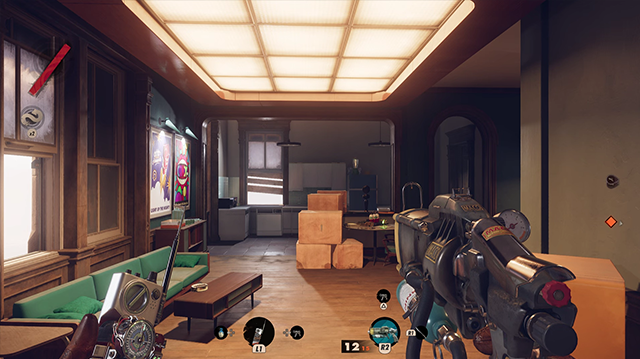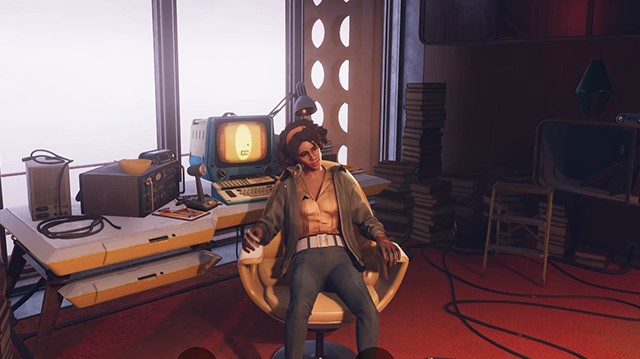It’s easy to look at Deathloop and think of games like Bioshock or Dishonored. The time loop premise has been seen before, in movies like Groundhogs Day or games like The Legend of Zelda: Majora’s Mask. These comparisons are apt but are ill-suited when trying to explain a game like Deathloop. After all, how useful can a reference be if what is new has exceeded its predecessors by so wide a margin?
Arkane Studios has always been incredibly talented. Titles like Dishonored and Prey (2017) were critical darlings if only moderate commercial successes. Deathloop is different. The scope, the fidelity, the polish — everything about this game far exceeds what they have done in the past. Deathloop might be the first true masterpiece of this generation.
Deathloop Review: A Masterpiece of Design and Style
Deathloop is a science fiction first-person shooter set in an alternate 1960s. You play as Colt and wake on a beach to discover you, and all the citizens on the island of Blackreef, are living in a time loop. Colt and a select few citizens called the Visionaries possess a strange and unique power. Every day, once the clock strikes midnight, the day reverts to the beginning. Everything that has happened is undone, and everyone begins again. It’s up to Colt to find a way to kill all of the Visionaries in a single day to break the loop.
What sets the story apart from something like Groundhogs Day or The Legend of Zelda: Majora’s Mask is that all citizens around you are aware of the time loop. It’s an intentional act. While Colt fights to break the loop, everyone else is protecting it. They’ve all embraced the hedonistic lifestyle that a consequence-free existence allows, and they won’t give it up willingly.
I won’t spoil the story, but it is one of the highlights of the game. Colt has a foil in Julianna, the other assassin on the island. She is his equal, an archrival who has taken it upon herself to try and kill Colt, gleefully sending him back to the start of the loop each day. She and Colt communicate via hand-held radio, and she has the ability to randomly jump into any level and attack Colt.
To break the loop, Colt needs to gather information. There are four levels in Deathloop, and each can be visited at one of four times of day. These levels change wildly with the time of day: different enemies, side missions, items, and available pathways shift with the clock. Time freezes while in a section, then advances when you leave to a new area, giving players all the time to explore they want.

Deathloop has strong roguelike elements, akin to Hades or Rogue’s Legacy. Dying or reaching the end of the day sends you back to the start. Early in the game, you will gain the ability to infuse items, allowing you to unlock a few items permanently. Thus, you start each run with new information or tools, allowing you to come ever closer to completing Colt’s mission in the time you have.
Deathloop oozes 1960s style out of every pore. Where Bioshock famously leans into art deco with a retro luxury style, Deathloop cloaks its main characters in a brash mod style alternative. There’s a cinematic synthesis where 60s James Bond and 70s Blaxploitation cinema meet. The music syncs perfectly with the action, using a driving beat that befits both the gameplay and the setting.
The leading characters of Colt and Julianna are cool as hell. Their clothing, movements, and fighting styles are riveting. The banter between them is so natural, effortlessly switching between playful taunting to slicing insults, and it is flawlessly executed.
Enemies are outfitted in anything from outrageous party clothes to cobbled-together suits that would look at home in the post-apocalypse. Their personalities are just as varied as are their reactions to discovering Colt. Some will charge with reckless abandon, while others will flee in search of help.
Colt has a number of archetypal weapons at his disposal, ranging from pistols to rifles, shotguns to nail guns. Each of these comes in varying rarities. Rarer versions of the same gun have more slots for weapon mods or unique abilities. After one fateful encounter, I found myself with the same model of a large pistol in each hand, but they had vastly different perks. One did bonus damage to certain enemies. The other left a cloud of noxious fumes wherever it struck.

Slabs control your powers. Colt always possesses a slab that allows him to respawn after dying up to two times in a single area before triggering a full reset of the day. Other powers are acquired by taking the slabs from slaying Julianna or one of the eight other Visionaries. It’s a brilliant risk/reward system.
Once you’ve killed and taken a slab, do you continue exploring an area looking for more clues, or do you play it safe and head for the exit? There is no wrong answer, but one that can have potentially painful consequences.
The powers bestowed by the slabs are varied and imaginative. There is the classic short-range teleport move, similar to what Arkane gives players in Dishonored. There are cloaking abilities, armor buffs, and telekinetic throws. One ability, called Nexus, allows you to link nearby enemies. Whatever happens to one happens to all. I audibly squealed with glee the first time I linked three enemies and kicked one off of a cliff.
Mixing gunplay and powers allows you to tailor the game to your playstyle. I found myself sneaking past enemies early on, only killing foes if I was sure no one would see me. My silenced pistol and invisibility allowed me to go almost anywhere I wanted, completely undetected.
In a later mission, I decided to mix things up. I grabbed my machete, a slab that gives temporary invincibility (with an upgrade that extends the duration of that invincibility further with kills), and my teleportation slab, living out Jason Voorhees dreams as I slaughtered every enemy in my path. Both playstyles work brilliantly.
Defeating the visionaries isn’t as simple as go to point A, kill someone, repeat. At first glance, there simply aren’t enough hours in the day to reach everyone. As you gather the information, you begin to learn about the Visionaries. You need to know their routines and their relationships with each other. Maybe a few of them have plans to gather in one place. Maybe one wants to do one thing, and you influence them to do another.
That may sound vague in this spoiler-free review, but the game does a great job keeping track for you. Every scrap of information you collect is stored, and each thread can be tracked. I often found myself going through an area looking to advance my plans to kill one Visionary, then checking my notes for other helpful tasks in that same area.
Themes of choice are central to gameplay here. You can always look for ways to advance toward breaking the loop, or you can decide to kill a visionary here and now to collect or upgrade a Slab. The Visionaries have powers comparable to Colt. You could run in guns blazing and make a boss fight out of it, sneak in for an assassination, or take advantage of the environment to create circumstances that keep your hands technically blood-free.

Deathloop ups the ante further with its built-in multiplayer mode. If you elect into multiplayer, the Julianna that invades your world will be controlled by another human player, ala Dark Spirits or Invaders in Dark Souls. The immediate stress and sweat-inducing cat and mouse nature of a human being hunting you down bring an element of unpredictability that no AI can provide.
Opting to play as Julianna and becoming the invader is an entire game mode unto itself. Julianna has a unique power that lets her trade appearance with any of the citizens of Blackreef, which is very useful for getting the drop on an unsuspecting player. Your performance as Julianna allows you to increase your Hunter Rank, unlocking new weapons and abilities for your next invasion.
Julianna has stealth and all of the Blackreef citizens (including Visionaries) on her side, but only one life. It makes for an interesting, asymmetrical player-versus-player experience.
There are so many things in this game that are great. The variety of locations, powers, weapons, and enemy behavior creates so many great moments. One second you are leaping rooftop to rooftop, high above the gaze of your enemies; the next, you are in a secret base a Bond villain would love, trying to remember the correct order by which to cut the wires so that you aren’t wiped out in a massive explosion.
Deathloop Review — The Bottom Line

Pros
- A brilliant twist on the time loop formula
- Incredible stylish
- Engaging cast of characters
- Creative power and weapons
- Myriad ways to approach levels and enemies
Every aspect of Deathloop, from its style to its story, to the gameplay, is brilliantly crafted. To say this is reminiscent of titles like Bioshock, Majora’s Mask, or Hades doesn’t do this game justice. It takes what those titles have done and builds upon them masterfully and imaginatively.
While it remains to be seen if the multiplayer mode remains compelling after release, Deathloop is, quite simply, the best game this new console generation has produced. Full stop. It is a must-play game, and we give it our highest recommendation.
[Note: Arkane Studios provided the copy of Deathloop used for this review.]







Published: Sep 13, 2021 03:44 am